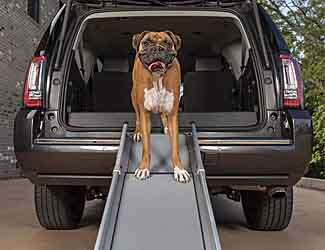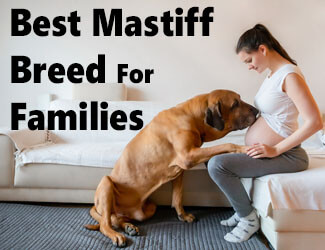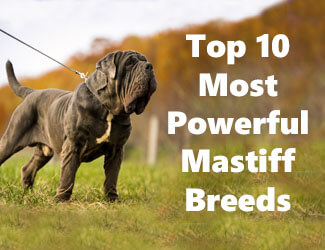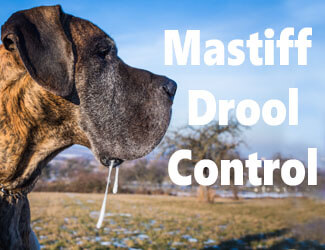Do Mastiffs Drool A Lot?
And Which Ones Slobber The Most Or Least?
by Ken Alden
Do mastiffs drool a lot? These ancient pups are
courageous and good-natured, but incredibly large and prone to drooling so let's get started by explaining...
Why Do Mastiffs Drool A Lot?
As a whole, Mastiffs drool quite a bit due to their large jowls. Saliva can accumulate here and quite literally leak out instead of being swallowed. Not all Mastiffs drool nearly as much as others though.
When asking do Mastiffs drool alot, for some pet owners, their excessive drooling is an instant deal-breaker. For others, it’s just more to love. This article covers the reasons why your mastiff might be drooling often as well as which breed types are a little more dry-mouthed, and of course, how to control the persistent slobber. Read More Below...
Pro-tip: Ever try lifting a Mastiff? Their weight can hurt not only your back but their joints when they hop down from cars, sofas or even your bed. To protect your back and theirs check out the best Mastiff ramps on Amazon.com now.
Table Of Content - Jump To Links
Why Do Mastiffs Drool?
What Triggers It?
Mastiff Drool Ratings
Mastiffs Breeds (A-Z) That Drool Most
Tips To Stop Drooling
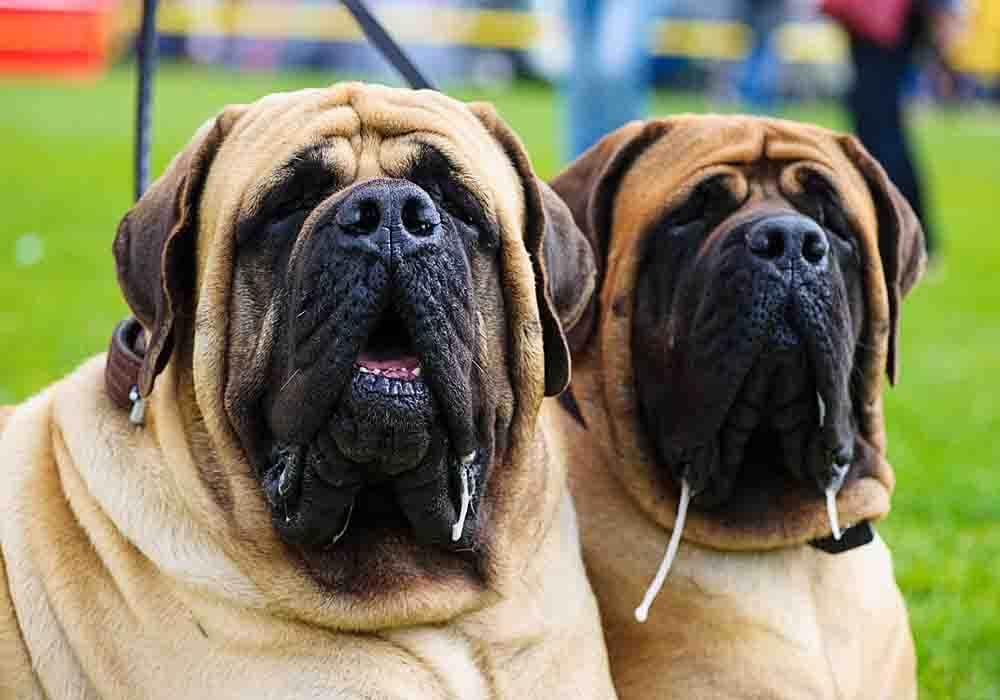
Why
Do Mastiffs Slobber So Much?...Is There Something That Triggers It?
The reason the Mastiffs slobber often leaks out is due to its saliva accumulation in the dog’s jowls. This is totally normal for this breed and can be made worse by the anticipation of being fed as well as other triggers.
This can also occur after the mastiff drinks; extra water can get stuck in the
folds as well. But if the pup hasn’t recently hydrated, why is there still so
much drool?
Food anticipation
This is a pretty common reason for extra salivation. Think of holding a treat in front of your dog. Does he drool with excitement? If your mastiff is expecting his dinner, he might be slobbering with excitement and leaking that saliva out of his loose lips. Don’t rush your pup off to the vet if he’s experiencing this — it’s nothing to worry about.
Throat blockage or dental issue
If your mastiff is excessively drooling and there’s no food in sight, it’s possible that something could be happening internally. There could be something in his throat that’s making swallowing difficult, resulting in a buildup of saliva. This could be a sign of something serious, like a tumor. It’s always best to take your dog to the vet if you think there might be something blocking his throat. Additionally, cavities, leftover food, or tartar buildup could all cause a little extra slobber.
Heatstroke
According to The Nest, mastiffs are actually more likely to get heatstroke due to their larger size. The excess salivation could be your dog trying to cool himself off; always make sure he has plenty of water and move him indoors if need be.
Anxiety
The fourth reason for your mastiff’s drooling could be anxiety. Make sure that nothing is bothering your pup and try to isolate an incident that could be causing these feelings. Was there a recent change in routine? Are you leaving your dog home alone a lot? These could all be reasons for your pup’s anxiety and excess drooling.
Do
Mastiffs Drool All the Time?
Mastiffs are known to drool throughout the day.
Aside from dinner time, there isn’t a specific part of the day where a mastiff
is more or less likely to be drooling since it really is due to the way they’re
built. It’s always smart to keep some extra towels on hand just in case your
mastiff decides to release the waterworks. Also, never discipline your mastiff
for extra drooling! Make sure you aren’t easily grossed out before adopting one
of these gentle and wet giants. do mastiffs drool a lot
How
Much Do Mastiffs Slobber?
There isn’t any real answer to how much mastiffs
slobber since it varies quite a bit between breed and specific pup. Normally,
a mastiff will only slobber when he’s hungry, anxious, or just took a huge gulp
of water. They do, however, drool quite a bit more than other breeds.
Mastiff owners suggest carrying around a towel to wipe up after your pup and
quickly get over any squeamishness about drool.
Of course, the biggest variation in drool amounts is the specific breed of the mastiff. There are several different mastiff types; some are more dry-mouthed whilst others are a little wetter in the face. This chart compares the different mastiff breeds with some of their characteristics, size, and their likeliness to drool. Read below for more detail about each individual breed. do mastiffs drool a lot
Note: General characteristics, height, and
weight are according to the American Kennel Club.
Mastiff Drool Ratings
On a 1-5 Scale, which Mastiff breeds slobber the least or most...
|
Breed Bullmastiff English Mastiff French Mastiff Cane Corso Great Dane Neapolitan Mastiff Tibetan Mastiff |
Drool Rating 3/5 4/5 4/5 2/5 1/5 5/5 2/5 |
Now let's dissect this a little further by talking about the drool habits of the above breeds and just how bad (or not bad) things can get with each one...
Which Mastiff Breeds Drool The Most/Least?
Do Bullmastiffs Drool A Lot?
The bullmastiff (a hybrid between a bulldog and
mastiff) is a little bit smaller and is equipped with a red or brindle coat.
They stand between 24-27 inches tall and weigh 100-130 pounds (according to the
American Kennel Club), and are known for their affection and loyalty. Bullmastiffs
also make good family or guard dogs due to their social skills.
Both of the bullmastiff’s parents are prone to
drooling, so you can also expect your bullmastiff to be a little moister in the
mouth. However, the amount your bullmastiff drools depends on the size of
his jowls. He will salivate for the same reasons — hunger, anxiety, or
underlying diseases — but the amount he actually produces will depend on his
physical makeup. Because bullmastiffs are slightly smaller than their
counterpart, you can expect their jowls to be smaller and, therefore, less
drool to clean up.
Pro-tip: Mastiff anxiety, aggression, destructive chewing, jumping up, fearfulness, and other behaviors can be controlled with the right training program.
Here’s a great course that
addresses these issues along with many other dog training basics: Check it out now!
Do English Mastiffs Drool A Lot?
When Googling “mastiff,” the breed that pops up
is actually an English mastiff. This pup is actually a very old breed,
descending from the Alaunt and Molosser breeds. Like the bullmastiff, English mastiffs are
good family and guard dogs that are friendly enough to watch over your kids
without getting rough with them. They’re easy to train, gentle, and sometimes
even a little bit shy, depending on how they were socialized as puppies.
This traditional pup is indeed a heavy drooler,
as we covered earlier in this article. Their large jowls make it difficult
for them to keep their saliva in their mouths, and it will often end up on
your floor or clothes. A good suggestion is keeping wipes on hand for cleaning
off your pup, or laying towels near their food and water bowls to avoid
unnecessary spillage. The Dog
Place also suggests keeping your toilet lids down to
avoid a mess of toilet water all over your carpet!
Do French Mastiffs Drool A Lot?
Dogue de Bordeaux, commonly known as the French
mastiff, is an ancient French pup with a sad expression and a lot of affection.
This mastiff relative is wrinkly, muscular, and equipped with a large head. It
can actually weigh significantly less than its counterparts, starting at around
99 pounds for a female.
The French mastiff does drool a lot due to
its loose lower lip. This looseness fails to keep saliva in the mouth and
throat, resulting in excess drooling. When combined with a shake, this drool
can get all over walls, furniture, and people! A simple Google search depicts
these friendly giants with strings of saliva dripping from their cheeks. They
can’t help it! It’s in their genetics. do mastiffs drool a lot
Do Italian Mastiffs Drool A Lot?
You might know the Italian mastiff by its other
name, the Cane Corso. These pups have the traditional large head and muscular
body of the other mastiffs, but often have pointier ears and fewer facial
wrinkles. They’re a little more intelligent than their relatives and are often
used as guard dogs.
Surprisingly, Cane Corsos actually don’t
drool as much as other mastiffs. However, this can indeed range between
individual Corsi. Pups with tighter lips and jowls will obviously drool less
than those with larger, looser jowls. Overall, Corsi tend to have smaller jowls
than other mastiffs, which makes them less drooly. But do still be prepared for
drool: it will come no matter what!
Do Great Danes Drool A Lot?
Great Danes (also known as German Mastiffs) are one of the biggest dog breeds
known to man. Their height ranges from 30-32 inches, and they can weigh as much
as 175 pounds, according to the American Kennel Club. When standing on their hind legs, these dogs are often as tall
(if not taller) than their human owners! Despite their intimidating size, Great
Danes are actually pretty gentle. They’re friendly and patient, which makes
them good dogs to have around younger kids. However, the large size and deep
bark are enough to scare away any potential intruder.
Surprisingly, the Great Dane isn’t actually
in the top ten
list of drooling dogs. This pup definitely
drools less than other mastiff relatives due to fewer wrinkles and tighter
jowls, but it does indeed tend to be moister than other dog breeds. A Great
Dane is a good way to go if you’re looking for a mastiff relative that’s easy
on the slobber, but remember that what you lose in saliva, you make up for in
sheer size.
Do Neapolitan Mastiffs Drool A Lot?
The Neapolitan mastiff is a gigantic, wrinkly
pup known for his powerful guard skills. They have large heads, muscular
bodies, and originated in ancient Rome. They’re also called the Mastino, and
according to the AKC, look like “a marzipan Mastiff that’s been out in the sun too
long.” Mastinos are sweet and loyal, but also powerful and intimidating dogs
perfect for guarding your home and family.
The Neapolitan Mastiff has an incredible tendency to
drool and shouldn’t be adopted by someone who’s put off by saliva. Their
increased number of wrinkles offers lots of places for extra saliva to hide for
later. Be careful when feeding and watering your Mastino, and make sure to have
towels on hand to clean up the inevitable mess.
Pro-tip: Mastiff's (and their owners) love dog crates…and for good reasons. Crates keep dogs from mischief while you're away, are perfect for house training, for traveling by car, and provide the dog a place to de-stress. Check out the best Mastiff crates on Amazon.com now.
Do Tibetan Mastiffs Drool A Lot?
Last is the Tibetan mastiff, a large, fluffy
guard dog known for its independence and loyalty. Similar to other mastiffs,
the Tibetan is very large and intimidating but differentiates itself with its
long fur and dark coat.
The Tibetan mastiff is actually a
dryer-mouthed breed, meaning that they are not constantly drooling. Of course,
they still have the potential to drool from hunger and thirst, and it will
indeed make a mess due to their large and loose lips, but it isn’t as common
for them to be constantly slobbering as it is for other mastiffs. A Tibetan is
a good choice if you want the size and loyalty without the excess amounts of
saliva. Do be warned though; even a dryer-mouthed mastiff will still produce an
awful lot of drool compared to other, smaller breeds.
Is
There A Mastiff That Doesn’t Drool?
Unfortunately, there is no mastiff breed that
doesn’t drool. All mastiffs drool to some degree due to their physical
appearance: loose jowls, wrinkles, and big lips. However, there are some
options for those who love the gentle giants but don’t want to deal with
puddles of saliva all over the floor.
As listed above, Tibetan mastiffs are a good choice if wondering do mastiffs drool a lot and you’re looking for a dryer-mouthed pup. They have slightly tighter lips that keep saliva from leaking out constantly. However, their fluffy coats don’t resemble other mastiffs, and they can be quite tough. do mastiffs drool a lotdo mastiffs drool a lot
If you’re looking for a dry-mouthed mastiff that better resembles the typical English mastiff, an American mastiff is a good breed to choose. This pup is still quite large, standing between 26 and 34 inches tall and weighing anywhere from 140 to 180 pounds, but like the Tibetan mastiff, this breed has fewer face wrinkles and tighter lips that help to prevent excess drooling.
The most important thing to remember, however,
is that all mastiffs will drool. The amount does vary based on breed,
facial structure, and underlying causes, but they do tend to produce extra
saliva than other dog breeds. Mastiffs are loyal, affectionate, and protective
pups; great for watching over your home and befriending your children, but they
are incredibly large and can be very messy, especially after a nice shake. Do
not adopt a mastiff if you are not prepared for the amount of slobber they
produce, or if you’re squeamish about a little drool on your legs.
How Do I Stop My Mastiff From Drooling?
Although there is no way to completely stop a Mastiff from drooling, you can control it to a certain extent by knowing when it's likely to drool as well as what triggers it so it can be better controlled.
There are several easy ways to deal with your
drooling pup that don’t cause any harm to him, and will hardly inconvenience
you. These include small changes like keeping towels on hand and changing into
good clothes after you’re done petting your furry friend. However, there are
also more drastic options to reduce drooling, including facial surgery.
Easy Solutions for Controlling Drool
Here is a list of ways to handle your dog’s extra saliva, from wiping down his face to getting over any squeamishness as soon as possible.
Keep towels on hand.
These towels serve many
purposes. Use them to wipe up the floor, wipe your pup’s face after he gets a
drink, or to mop up any saliva splashes after a shake. Designate towels specifically
for removing drool, and wash them regularly to keep them from getting too
gross.
Arm your pup with a bandana bib!
Bandanas are a great
accessory for your handsome pup, and they’re super customizable! Bandanas will
help to catch some of the drool from your pup’s face before it hits the floor,
and you can also use it as a towel to wipe him off after a drink. Hit the
fabric store and make your own, or you can purchase a bandana at any pet store
or online. Have fun with it; there are so many options for patterns and colors
that will make your pup shine.
Be careful with what you wear.
If you know you’re about
to feed, walk, or play with your pup, wear something that can get dirty. Don’t
put on your nice work clothes before petting your drooling dog; that’s a recipe
for disaster! Instead, only change into your nice clothes right before leaving
the house. Maybe keep a change of clothes specifically for hanging out with
your dog, like an old T-shirt and shorts.
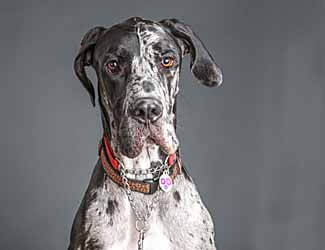
If you're looking for tips to control mastiff drooling, we've got a whole page dedicated to the best ways to reduce your dogs drooling.
Surgery for Drooling Dogs
There is another option for dealing with your
dog’s drool, and that is facial surgery such as cheiloplasty. This is a
procedure that reduces the size of the lips and tightens excess skin around
the mouth to keep saliva from pooling out the sides. There are some reasons
to do this surgery, such as reducing lip infections or tumors in your dog. Otherwise,
it’s not recommended as this is a mainly cosmetic surgery and would be done
solely to stop your pup from drooling. It’s not suggested to alter your dog’s
appearance for your own aesthetic purposes; don’t adopt a mastiff if you can’t
handle some extra saliva!
Do Mastiffs Drool A Lot? Some Final
Thoughts...
Mastiffs are giant, gentle, and loyal pups that
make a great addition to any family. However, along with their sheer size comes
an excessive drooling problem due to their loose jowls and extra skin around
the mouth. There are plenty of ways to combat this drooling while still
offering a mastiff a forever home. With a little bit of research, you can be
ready with a drool towel in one hand and a lot of love in the other.

About the Author...
Ken Alden, a dedicated Mastiff owner for over eight years, is acclaimed for his expertise in care, grooming, and training. Read more About Me and my dog Shadow.
- Mastiff Guide Home ›
- Best Mastiff Products ›
- Do Mastiffs Drool A Lot?





